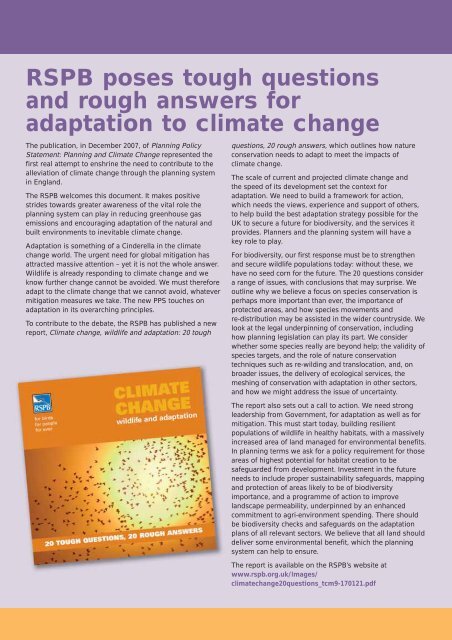Conservation Planner issue 28 - RSPB
Conservation Planner issue 28 - RSPB
Conservation Planner issue 28 - RSPB
You also want an ePaper? Increase the reach of your titles
YUMPU automatically turns print PDFs into web optimized ePapers that Google loves.
<strong>RSPB</strong> poses tough questions<br />
and rough answers for<br />
adaptation to climate change<br />
The publication, in December 2007, of Planning Policy<br />
Statement: Planning and Climate Change represented the<br />
first real attempt to enshrine the need to contribute to the<br />
alleviation of climate change through the planning system<br />
in England.<br />
The <strong>RSPB</strong> welcomes this document. It makes positive<br />
strides towards greater awareness of the vital role the<br />
planning system can play in reducing greenhouse gas<br />
emissions and encouraging adaptation of the natural and<br />
built environments to inevitable climate change.<br />
Adaptation is something of a Cinderella in the climate<br />
change world. The urgent need for global mitigation has<br />
attracted massive attention – yet it is not the whole answer.<br />
Wildlife is already responding to climate change and we<br />
know further change cannot be avoided. We must therefore<br />
adapt to the climate change that we cannot avoid, whatever<br />
mitigation measures we take. The new PPS touches on<br />
adaptation in its overarching principles.<br />
To contribute to the debate, the <strong>RSPB</strong> has published a new<br />
report, Climate change, wildlife and adaptation: 20 tough<br />
questions, 20 rough answers, which outlines how nature<br />
conservation needs to adapt to meet the impacts of<br />
climate change.<br />
The scale of current and projected climate change and<br />
the speed of its development set the context for<br />
adaptation. We need to build a framework for action,<br />
which needs the views, experience and support of others,<br />
to help build the best adaptation strategy possible for the<br />
UK to secure a future for biodiversity, and the services it<br />
provides. <strong>Planner</strong>s and the planning system will have a<br />
key role to play.<br />
For biodiversity, our first response must be to strengthen<br />
and secure wildlife populations today: without these, we<br />
have no seed corn for the future. The 20 questions consider<br />
a range of <strong>issue</strong>s, with conclusions that may surprise. We<br />
outline why we believe a focus on species conservation is<br />
perhaps more important than ever, the importance of<br />
protected areas, and how species movements and<br />
re-distribution may be assisted in the wider countryside. We<br />
look at the legal underpinning of conservation, including<br />
how planning legislation can play its part. We consider<br />
whether some species really are beyond help; the validity of<br />
species targets, and the role of nature conservation<br />
techniques such as re-wilding and translocation, and, on<br />
broader <strong>issue</strong>s, the delivery of ecological services, the<br />
meshing of conservation with adaptation in other sectors,<br />
and how we might address the <strong>issue</strong> of uncertainty.<br />
The report also sets out a call to action. We need strong<br />
leadership from Government, for adaptation as well as for<br />
mitigation. This must start today, building resilient<br />
populations of wildlife in healthy habitats, with a massively<br />
increased area of land managed for environmental benefits.<br />
In planning terms we ask for a policy requirement for those<br />
areas of highest potential for habitat creation to be<br />
safeguarded from development. Investment in the future<br />
needs to include proper sustainability safeguards, mapping<br />
and protection of areas likely to be of biodiversity<br />
importance, and a programme of action to improve<br />
landscape permeability, underpinned by an enhanced<br />
commitment to agri-environment spending. There should<br />
be biodiversity checks and safeguards on the adaptation<br />
plans of all relevant sectors. We believe that all land should<br />
deliver some environmental benefit, which the planning<br />
system can help to ensure.<br />
The report is available on the <strong>RSPB</strong>’s website at<br />
www.rspb.org.uk/Images/<br />
climatechange20questions_tcm9-170121.pdf
















